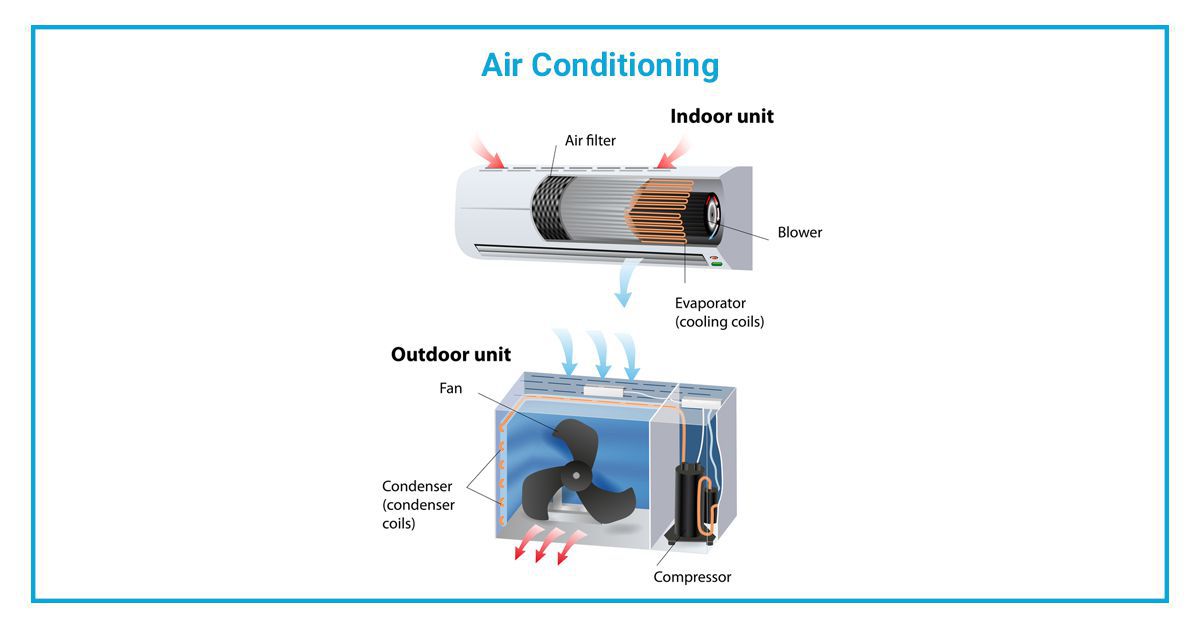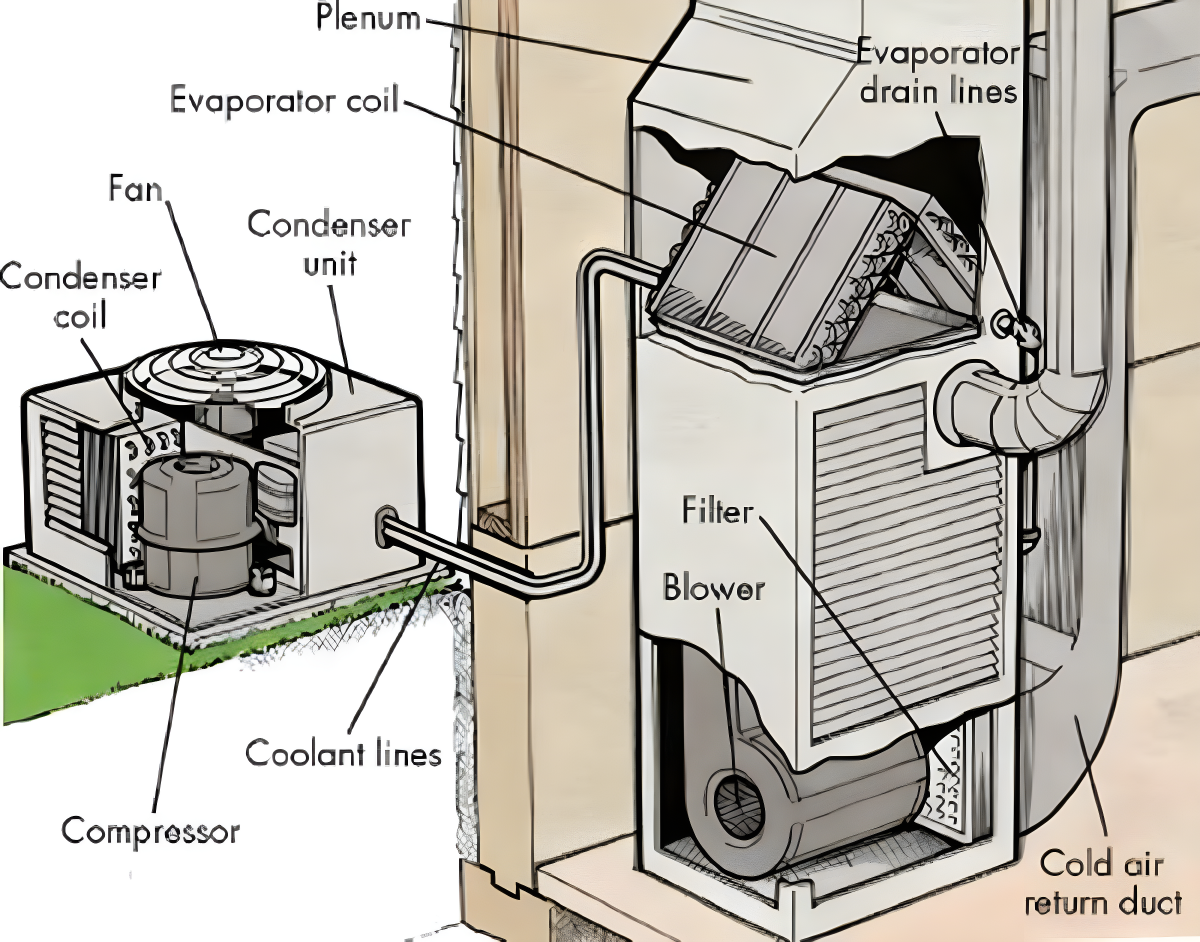What Purpose Does Air Conditioning Serve
:max_bytes(150000):strip_icc()/what-are-central-air-conditioners-1152645_V2-390c6f1f6ca14b4ebc59426f226a78a8.png)
Imagine this: It's a sweltering summer afternoon. You arrive home, eager for the cool embrace of your air conditioning, only to be met with… nothing. Just warm, stagnant air. A malfunctioning air conditioner can be more than an inconvenience; it can be a serious health hazard, especially for the elderly, infants, and individuals with pre-existing medical conditions. But before you panic and call an expensive repair service, let's explore some basic troubleshooting steps you can safely attempt.
Understanding the Purpose of Your Air Conditioning
First, let's refresh our understanding of what your AC is actually doing. Air conditioning doesn't just cool the air; it performs several vital functions:
- Cooling: This is the most obvious. The AC unit removes heat from the air inside your home, lowering the temperature.
- Dehumidifying: A significant portion of how we perceive temperature is related to humidity. AC units remove moisture from the air, making you feel cooler even at the same temperature.
- Air Circulation: AC systems circulate air throughout your home, preventing stagnant air pockets and ensuring more even temperature distribution.
- Air Filtration: Many AC units have filters that remove dust, pollen, and other allergens from the air, improving indoor air quality.
Knowing these functions helps you diagnose the problem. Is it just not cooling, or is the air also feeling damp? Is the airflow weak? These observations will guide your troubleshooting.
Common AC Failure: The Unit Won't Turn On
One of the most frustrating AC problems is when the entire unit refuses to power on. This can stem from various issues, ranging from simple fixes to complex repairs. Let's tackle this step-by-step.
Step 1: Check the Power Supply – The Easiest First Step
Never underestimate the power of a simple check. Start with the obvious:
- The Thermostat: Is it set to "Cool" and at a temperature lower than the current room temperature? A common mistake is accidentally setting it to "Heat" or "Fan Only." Important: Ensure the thermostat is properly configured for your AC system (e.g., heat pump vs. central AC).
- The Circuit Breaker: Locate the circuit breaker panel in your home. Identify the breaker that controls your AC unit (it should be labeled). Is it tripped (switched to the "Off" position or in a middle position)? If so, switch it fully to the "Off" position and then back to "On." If it trips again immediately, do not keep resetting it. This indicates a serious electrical problem requiring professional attention.
- The Power Switch: Many AC units have a dedicated power switch near the outdoor unit. Make sure it's in the "On" position. Sometimes, these switches get accidentally bumped off.
- Batteries (Thermostat): If your thermostat is battery-powered, replace the batteries. Low batteries can cause erratic behavior.
Safety Note: Always exercise caution when working around electricity. If you are uncomfortable working with electrical components, call a qualified electrician.
Step 2: Inspect the Outdoor Unit (Condenser)
The outdoor unit, or condenser, is a crucial part of the AC system. Problems here can prevent the entire system from working.
- Obstructions: Is the condenser unit blocked by debris like leaves, branches, or overgrown plants? Clear any obstructions to ensure proper airflow. Poor airflow reduces efficiency and can cause overheating.
- Dirty Fins: The condenser fins (the thin metal plates surrounding the unit) can get clogged with dirt and dust. Use a garden hose (with a gentle spray) to clean the fins from the inside out. Avoid using a pressure washer, as it can damage the fins. Specialized fin combs can help straighten bent fins for improved airflow. Important: Turn off the power to the unit at the breaker before cleaning.
- Fan Condition: Visually inspect the fan blades inside the condenser unit. Are they damaged or obstructed? If you see damage or excessive debris, do not attempt to repair it yourself. This requires professional attention.
Step 3: Check the Indoor Unit (Evaporator) and Filter
The indoor unit, usually part of your furnace or air handler, contains the evaporator coil and air filter. These components are often overlooked.
- Air Filter: This is the most common cause of AC problems. A dirty air filter restricts airflow, causing the system to work harder, overheat, and eventually fail. Replace the air filter regularly (typically every 1-3 months, depending on usage and air quality). Use the recommended filter type and size for your unit. A clean filter improves efficiency and prolongs the life of your AC system.
- Frozen Evaporator Coil: If the air filter is severely clogged, or if there's a refrigerant leak, the evaporator coil can freeze over. If you suspect a frozen coil, turn off the AC and set the fan to "On" to help thaw it. It may take several hours for the coil to thaw completely. Once thawed, replace the air filter and try turning the AC back on. If the coil freezes again quickly, you likely have a more serious problem requiring professional attention (e.g., refrigerant leak).
- Drainage Issues: Condensation from the evaporator coil needs to drain properly. A clogged drain line can cause water damage and shut down the AC system. Look for a small drain pipe near the indoor unit. You can try clearing the drain line with a wet/dry vacuum or a stiff wire. Pouring a cup of diluted bleach down the drain line periodically can help prevent clogs.
Step 4: Thermostat Settings and Calibration
Sometimes, the problem isn't with the AC unit itself, but with the thermostat controlling it.
- Programming Errors: Review the thermostat's programming. Are there any incorrect settings or scheduling conflicts? Make sure the thermostat is set to "Cool" mode and the desired temperature is lower than the current room temperature.
- Calibration Issues: Some thermostats can become inaccurate over time. Check the thermostat's manual for instructions on how to calibrate it. You can also compare the thermostat's reading to a reliable thermometer to see if there's a significant discrepancy.
When to Call a Professional – This is Crucial
While many AC problems can be resolved with simple troubleshooting, some issues require the expertise of a qualified HVAC technician. Never attempt repairs that you are not comfortable with, especially those involving electricity, gas, or refrigerant.
Call a professional if:
- The circuit breaker trips repeatedly after you reset it. This indicates a serious electrical fault.
- You suspect a refrigerant leak. Refrigerant is a hazardous substance, and handling it requires specialized equipment and training. Leaks can be harmful to the environment and pose a health risk.
- The compressor is not working. The compressor is the heart of the AC system, and its repair or replacement is a complex and expensive procedure.
- You hear unusual noises coming from the AC unit (e.g., grinding, squealing, hissing). These noises can indicate mechanical problems that require professional diagnosis.
- The evaporator coil freezes repeatedly even after replacing the air filter. This suggests a refrigerant issue or other underlying problem.
- You are not comfortable working with electrical components or gas lines. Your safety is paramount.
- You have exhausted all the basic troubleshooting steps and the AC is still not working.
Preventative Maintenance: A Key to Longevity
The best way to avoid AC problems is to perform regular preventative maintenance. This will not only extend the life of your AC system but also improve its efficiency and save you money on energy bills.
- Regularly replace the air filter (every 1-3 months).
- Clean the condenser fins annually.
- Clear any obstructions around the outdoor unit.
- Schedule an annual maintenance check with a qualified HVAC technician. They can inspect the system for potential problems, clean the coils, check the refrigerant levels, and lubricate moving parts.
By following these troubleshooting steps and implementing a preventative maintenance plan, you can keep your AC system running smoothly and enjoy a cool and comfortable home all summer long. Remember, when in doubt, always err on the side of caution and call a professional.










